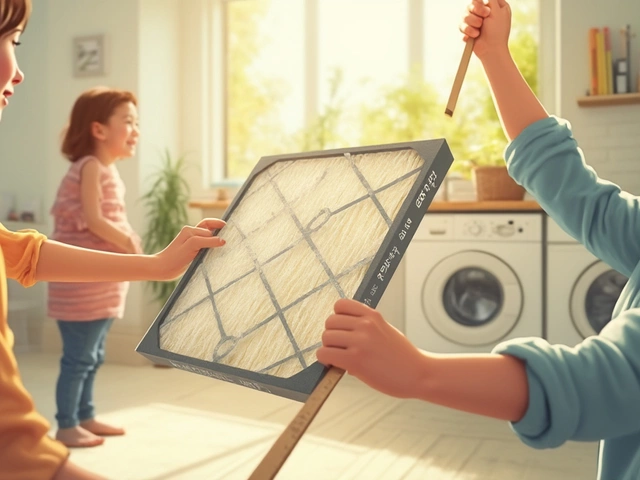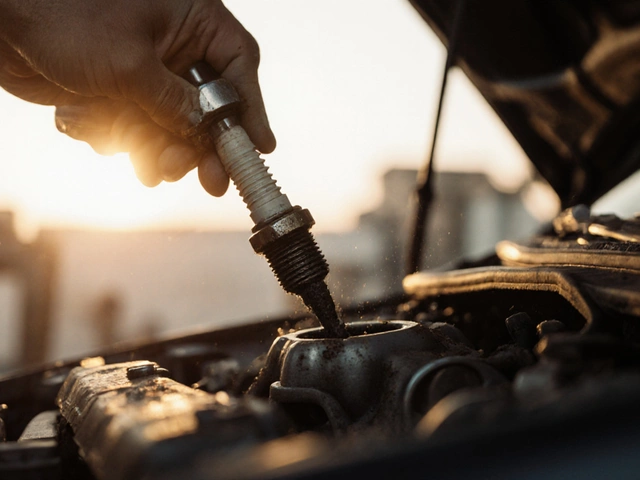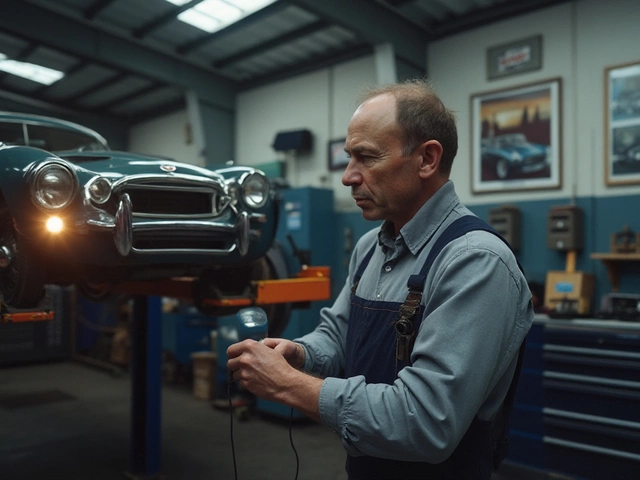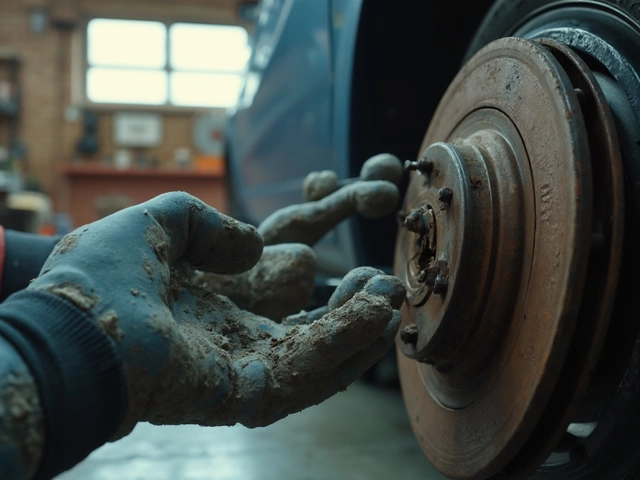So, you're thinking of putting new rotors with old brake pads, huh? It's a common question in the world of car maintenance. The short answer: it depends. Let's break it down so you can make an informed decision.
First off, brakes aren’t just a stop-and-go mechanism. They’re a whole system with rotors, pads, and calipers all working together. When you push that pedal, your pads press against the rotors to slow you down, and this connection is crucial. Old pads on new rotors? There're pros and cons. One pro: you'll save some bucks by not replacing everything. But here's where it gets dicey: old pads may have wear patterns that match the worn old rotors, possibly leading to uneven contact and reduced braking efficiency with the new ones.
- Understanding Brake System Basics
- Compatibility Concerns
- When to Consider Replacing Pads
- Cost Implications
- Safety Considerations
- Expert Opinions
Understanding Brake System Basics
Alright, let's dive into the nuts and bolts of your car's brake system. It might seem like a big mysterious thing, but at its core, it’s all about friction and pressure. Here's the scoop: when you hit the brake pedal, you're setting off a chain reaction that gets your car to stop—or at least slow it down.
Key Components
The main players here are the rotors, brake pads, and calipers. The rotors are the discs that the pads clamp onto. These big metal discs rotate with your wheels. Now, the brake pads are those flat, cushiony parts that press against the rotors to create stopping power. Finally, you've got the calipers, which are like the clamps that house the pads and squeeze them against the rotors.
How It All Works
When you press the brake pedal, brake fluid flows through a set of pipes and hoses to each wheel's caliper. This force causes the calipers to push the pads against the rotors. The magic happens because this friction between pad and rotor converts the motion (or kinetic energy) into heat. That's what slows the car down.
Why the Quality Matters
Not all brake systems are made equal. Better quality pads and rotors tend to last longer and offer better stopping power, especially in wet or emergency situations. For instance, high-performance vehicles often sport ventilated rotors to dissipate heat more efficiently.
When to Check
It's a good rule of thumb to check your brake components regularly. A quick way to tell if your brakes need attention is by listening for squealing sounds—it's often the first sign that your pads are wearing thin. If you're feeling vibrations or a spongy pedal, it's worth a deeper look.
In simple terms, staying on top of your brake maintenance isn’t just about extending the life of your pads and rotors. It's about keeping you and your passengers safe on the road. So, keep that in mind next time you’re tempted to skip a checkup!
Compatibility Concerns
When thinking about matching new rotors with old brake pads, there's more to consider than just the financial savings. The main concern lies in how these two components interact physically. Let's dive a bit deeper.
Uneven Wear Patterns
Every set of brake pads develops its own unique wear pattern based on the old rotor's surface. When you introduce a new rotor into this equation, those entrenched patterns don't just go away. Instead, they can lead to uneven contact between the brake pads and the new rotor. This contact mismatch might cause noise, reduced braking efficiency, or even vibrating pedals when stopping.
Risk of Rotor Damage
Using old pads on new rotors can sometimes lead to faster wear on the rotor itself. Old brake pads might have grooves or hard spots that can scratch, score, or glaze the surface of the new rotor. These imperfections can lower the rotor's lifespan and lead to additional costs down the line.
Manufacturer Recommendations
Always check what your vehicle's manufacturer suggests. Most vehicle manufacturers recommend pairing new rotors with new pads. This isn’t just a money-making scheme—it's about ensuring optimal performance and safety. The right materials and compatibility can dramatically increase the lifespan of both parts.
The Question of Bedding In
Did you know that both brake pads and rotors need to be bedded in? Bedding in is crucial as it ensures the pad surface mates correctly to the rotor's new surface. With old pads, you might skip this step, leading to compromised performance, since they are already bedded to the old rotor's surface.
| Scenario | Outcome |
|---|---|
| New Pads with New Rotors | Optimal Performance |
| Old Pads with New Rotors | Possible Uneven Wear |
| Old Pads with Old Rotors | Increased Wear, Unsure Performance |
At the end of the day, your brake system's effectiveness is paramount, and each change carries potential impacts. It's always worth discussing with a trusted mechanic if you're unsure about making changes—especially when it involves vital parts like your brake pads and rotors.
When to Consider Replacing Pads
Deciding when to swap out those old brake pads can get a bit heady if you're not in the know. The general rule of thumb? When there's less than a quarter-inch of pad left, it's usually game over for those old pads. But there are some other indicators that might nudge you to make that change sooner.
Wear Indicators and Noise
Your car might be sending you subtle hints — squealing, squawking, or grinding noises are cries for help. Many brake pads come with a wear indicator, a tiny piece of metal that makes contact with the brake rotor and emits a squeal when pads have worn too thin. Listen up because they're designed to catch your attention.
Performance Red Flags
If you notice your car taking longer to come to a stop, it's time to consider checking those pads. Old **brake pads** on new **rotors** might mean losing the edge on stopping power. It's vital for ensuring those quick emergency stops.
"Regular maintenance and inspection can save you from costly repairs. Never underestimate the significance of a well-maintained brake system," advises John Parker, a seasoned auto mechanic with over 20 years of experience.
Visual Inspection
Taking a peek at the brake pads through the wheel will also tell you a lot. Can't see much pad material left? Then it's pretty much a no-brainer. Replace them before you end up damaging those shiny new rotors.
Time and Mileage
Most brake pads last between 20,000 to 70,000 miles, depending on driving habits and conditions. City drivers often need replacements sooner, thanks to frequent stop-and-go traffic. So, if hitting the upper range, it might be the perfect time for a pad check.
Table: Average Lifespan of Brake Pads
| Driving Condition | Mileage |
|---|---|
| City Driving | 20,000-30,000 miles |
| Highway Driving | 40,000-50,000 miles |
| Mixed Conditions | 30,000-40,000 miles |
Being proactive with these checks not only keeps your brake system in tip-top shape but also keeps you and others safe on the road. After all, nothing beats a smooth, confident stop.
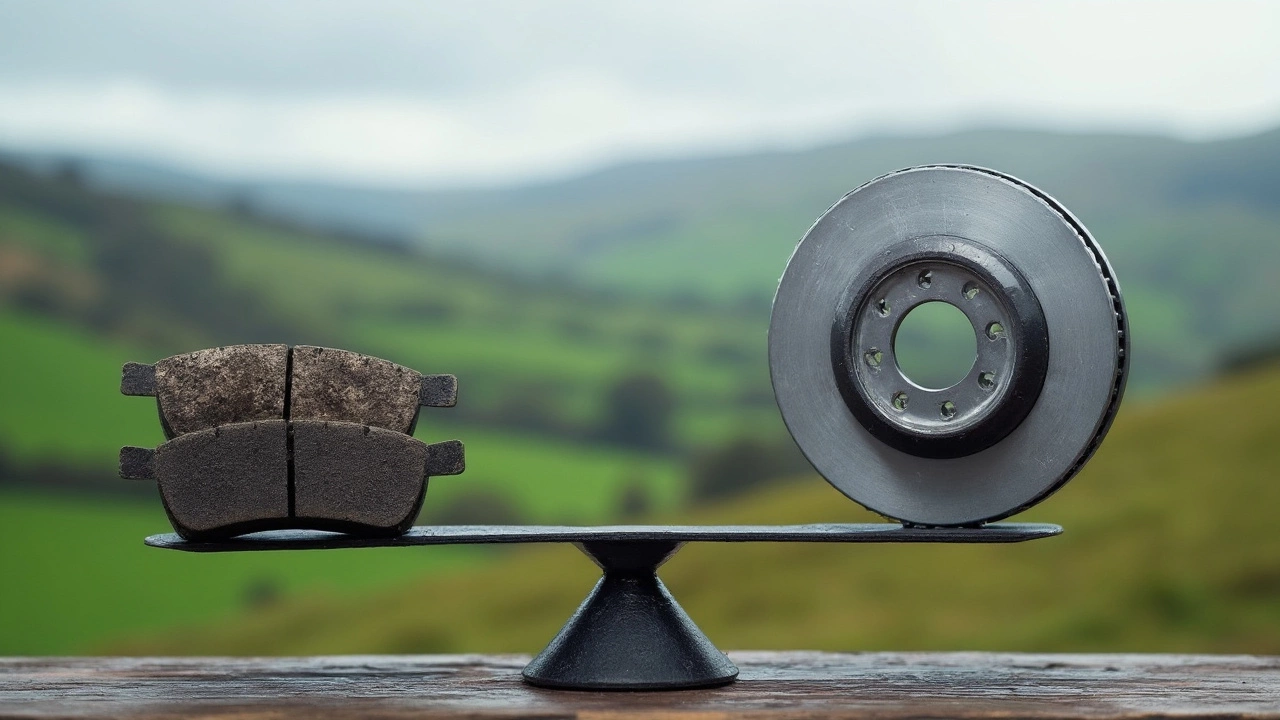
Cost Implications
Let's talk dollars and cents here. Deciding to mix new rotors with old brake pads can affect your wallet in a few ways. You might save initially by not swapping out everything, but there could be long-term costs to think about.
Savings on Immediate Parts
First, let's look on the bright side. Replacing just the rotors is obviously cheaper upfront. New rotors can cost anywhere from $30 to $75 each, depending on your car. Compare that with buying a full set of brake pads, which could hit you anywhere from $45 to $100 or more. If the old pads aren't worn down, you skip that extra cost.
Potential Hidden Costs
But here’s the kicker: mixing old brake pads with shiny new rotors might lead to uneven wear, potentially causing your pads to degrade faster. If that happens, you're looking at yet another replacement sooner than expected. Not to mention, uneven wear might lead to applied pressure in the wrong places, causing more heat and possibly warping those new rotors.
Weighing Risk vs. Reward
So, what's the trade-off? Shelling out a bit extra now for new pads might actually stretch the life of your rotors, saving bucks down the road by avoiding warping or having to replace them again so soon.
In a nutshell, while savings are tempting, the balance between immediate cost reduction and potential longer-term expenses needs to be considered carefully. It's all about finding that sweet spot that keeps both your brakes—and your budget—running smooth.
Safety Considerations
Let's get real: when it comes to your brakes, safety is king. Using old brake pads with new rotors could seem like a money saver, but what about the potential risk down the line?
Uneven Wear and Tear
Brakes are like shoes: if they don't fit right, they're not going to work as well as they should. Old pads usually have wear patterns that matched your old rotors. Slapping them on new rotors can create uneven pressure. This mismatch might reduce the efficiency of your brakes, meaning longer stopping distances or even a terrifying brake failure in a critical moment.
Reduced Performance
There's always a chance that your brakes won't perform at their peak if you reuse pads with new rotors. Over time, wear and heat cause pads to lose material and effectiveness. Old pads might not provide the friction required for proper grip on fresh rotors. Your car might not respond properly when you hit the brakes, potentially leading to accidents.
Manufacturer Guidelines
How often do you read your car’s manual? Automakers often recommend changing both rotors and pads at the same time. Not just as a precaution, but because it ensures harmonious integration within your brake system, maximizing the lifespan of both.
| Risk | Impact |
|---|---|
| Uneven Contact | Reduced braking ability |
| Heat Buildup | Possible rotor warping |
| Material Incompatibility | Worse performance |
All in all, safety should be your priority. Know your driving habits, consider your typical road conditions, and remember that brakes are what stand between everything going right and a potentially dangerous situation. So, if you’re unsure, maybe it's worth investing in those brake pads too.
Expert Opinions
When it comes to mixing new rotors with old brake pads, opinions in the auto industry are diverse, yet enlightening. Many expert mechanics have faced this question and offer practical advice based on years of experience.
According to a recent survey by the National Institute for Automotive Service Excellence (ASE), 70% of certified mechanics recommend changing both rotors and pads simultaneously to ensure optimal performance and longevity. The reasoning? Pads tend to develop wear patterns over time that might not fit with fresh rotors, leading to increased stopping distances.
Voices from the Garage
John Thompson, a seasoned mechanic with over 30 years of experience, shares his view,
"It's like wearing old shoes with new soles. Sure, they might fit, but there’s no guarantee they’ll perform as well. It’s always better to keep both components fresh to maintain your car's stopping power."
Another notable perspective comes from Lisa Wang, a brake specialist based in Texas. She emphasizes the cost-effectiveness of replacing both parts, stating, "In the long run, saving a few bucks on pads can lead you to more frequent rotor replacements, wrecking any chunk of change you thought you were saving."
Testing and Performance
A study conducted by the Automotive Training Institute highlighted that vehicles with mismatched brake pads and rotors experienced a 10% decrease in braking efficiency. Given this data, it’s no wonder why pros lean toward replacing both at the same time.
| Component | Recommended Replacement (Miles) |
|---|---|
| Rotors | 50,000 |
| Brake Pads | 20,000 |
This table summarizes common mileage recommendations, underscoring why some experts advocate for simultaneous replacements. As you can see, though brake pads wear out quicker, keeping their lifecycle in sync with rotors might prevent suboptimal braking performance.
Remember, whether you're a spirited driver or simply commute daily, consulting with a trusted mechanic about what's right for your car could save you a lot of fuss down the road. Balance safety, cost, and advice from those who know car maintenance inside out. Your brakes are not something to gamble with.


